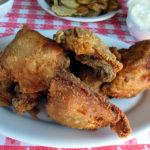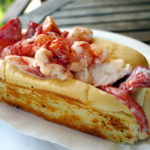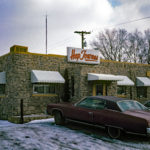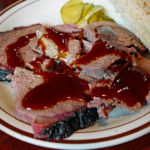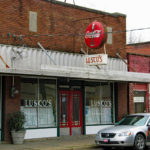Cafe Poca Cosa
Situated in an unprepossessing slab sided hotel called the Park Inn International in Tucson, Arizona, Café Poca Cosa is the finest Mexican restaurant in town and one of the best in the Southwest. To eat here is a dining-out experience reminiscent of the magical world of Like Water for Chocolate: lusty, passionate, delicious, and irresistibly Mexican. The fare at Poca Cosa isn't like that served in most other Mexican-style restaurants either north or south of the border. There are no numbered combination plates, not even any chimichangas or burritos, both of which are Tucson staples. Neither is it correct to call Poca Cosa's chili-accented menu trendy. This kitchen is too independent to fit the pigeonhole of a culinary trend, and it is probably too creative to set one. The repertoire includes dishes from nearby Sonora, Mexico, and faraway Oaxaca, as well as some that are entirely original; and everything is presented with élan in a dining room created by an artist.
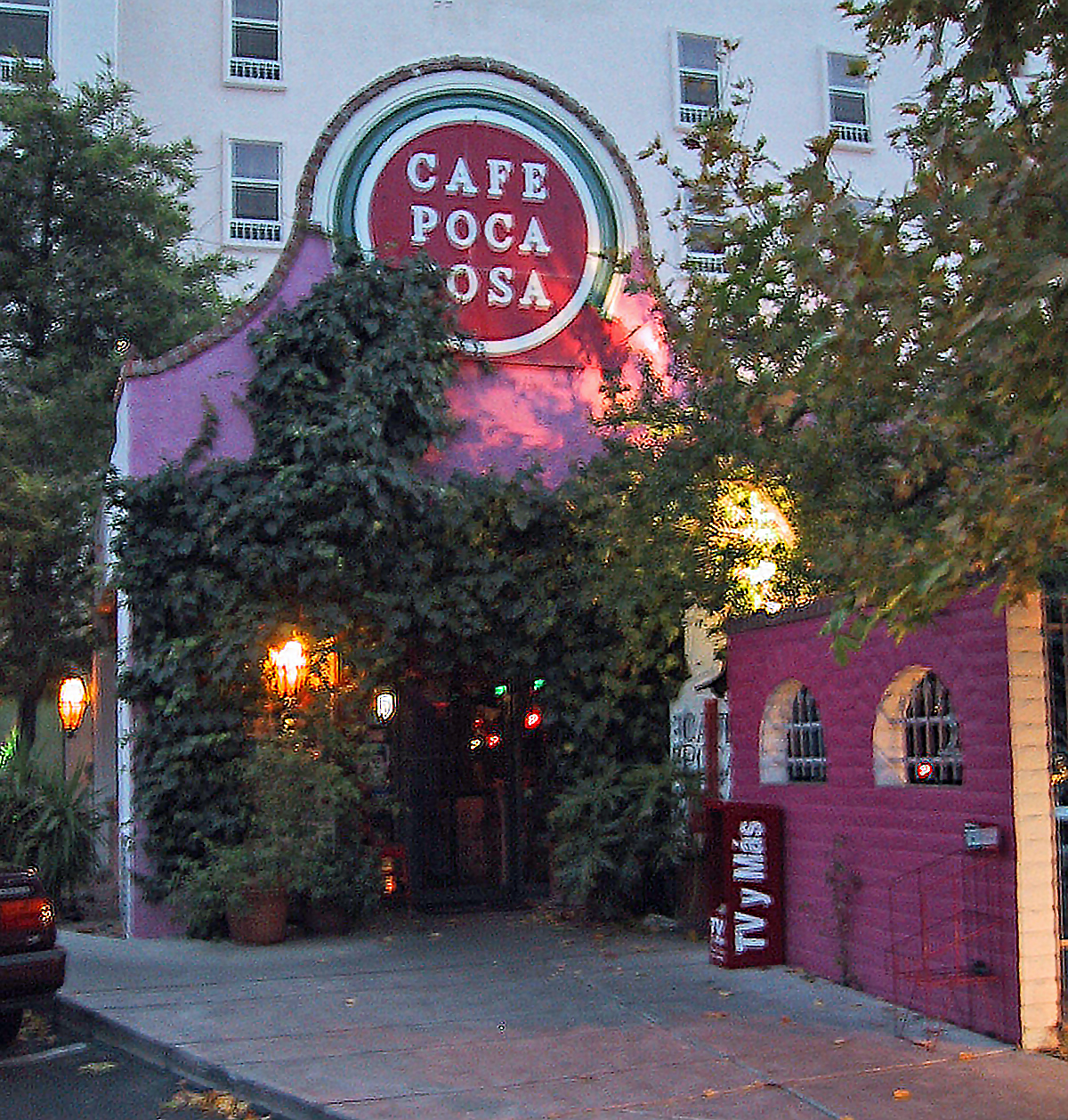
By Jane and Michael Stern
Originally Published 1995 Gourmet Magazine
Situated in an unprepossessing slab sided hotel called the Park Inn International in Tucson, Arizona, Café Poca Cosa is the finest Mexican restaurant in town and one of the best in the Southwest. To eat here is a dining-out experience reminiscent of the magical world of Like Water for Chocolate: lusty, passionate, delicious, and irresistibly Mexican. The fare at Poca Cosa isn’t like that served in most other Mexican-style restaurants either north or south of the border. There are no numbered combination plates, not even any chimichangas or burritos, both of which are Tucson staples. Neither is it correct to call Poca Cosa’s chili-accented menu trendy. This kitchen is too independent to fit the pigeonhole of a culinary trend, and it is probably too creative to set one. The repertoire includes dishes from nearby Sonora, Mexico, and faraway Oaxaca, as well as some that are entirely original; and everything is presented with élan in a dining room created by an artist.
The auteur is Suzana Davila, who took over and completely redesigned the place six years ago when the hotel coffee shop—basic beige with a menu to match—became available. “We only had a few days from the time they vacated to when Poca Cosa was supposed to open,” she recalls. “So my friends and I got in here and painted like wild. The evening we opened for business the dining room still smelled of paint. In the establishment’s new incarnation the walls were lacquered bright red and orange; the ceiling was transformed from cottage cheese—textured drab to leafy green; and a seldom used patio was restored complete with a tiled fountain and lush Sonoran desert plantings. “In the beginning, some people asked, ‘Who wants to eat in a bright red restaurant?'” Ms. Davila remembers. “But I believe the environment should reflect the food. Bright colors express what I do in the kitchen. Red awakens the appetite.”
Café Poca Cosa can be entered either from a parking lot shadowed by the hotel tower or through the lobby, past the Hair and Nail Artistry Salon. Once you are inside the restaurant, basking in the azure-walled patio or ensconced in the dining room on equipales, chairs of wicker and pigskin, the mundane exterior surroundings fade away. “We sit here and pretend we are all on our own,” Ms. Davila says as she shows guests the fish in her patio fountain and the chilies and herbs that thrive in this paradisiacal corner of the old Tucson neighborhood that used to be the city’s heart.
Suzana Davila is a woman with an inexorable sense of style. A former model and interior designer, she is a spellbinding presence in the restaurant when she comes from the kitchen to greet friends. Outfitted in a broad-brimmed, low-crowned straw hat, her hair pulled back tight and an infectious smile on her face, she has the grand aura of a chef combined with the charm of all Mexico. “This is the most delicious mole I have ever eaten,” a customer calls out to her as she passes his table. He is eating pollo en mole verde, chicken in a sauce that includes green serrano chilies, tomatillos, pistachio nuts, pumpkin seeds, and almonds. “I know, I know,” she answers him enthusiastically, clasping both hands to her heart. “It is good because it is made with love.” Love and passion, even more than chilies and coriander, are the vital ingredients of Poca Cosa’s kitchen.
Ms. Davila grew up around the restaurant business, but her father, who ran a restaurant in Guaymas, Sonora, advised her to stay away: too much hard work, too many long hours. In the seventies and eighties she found herself in Tucson working as a model, furniture designer, and occasional food stylist. When she was downtown, she used to eat in a lunchroom called La Indita, on South Scott Avenue next to the Federal Building. It was a minuscule shoe box of a café with room for about twenty customers at a time; when the opportunity arose, in 1986, she bought it. “I knew I loved to cook,” she says, “and that I had an eye for design. But that was all I knew. I painted the place in bright colors, brought in Mexican furniture, and waited for customers.”
At the time, downtown Tucson was undergoing drastic renovations. Whole streets were blocked off and torn up. Although the point of the work was to make the city core more attractive for shoppers, the construction turned it into a temporary dead zone. “For months I had no customers whatsoever,” Suzana recalls. But if there is one quality this woman radiates (beyond the benign wizardry she shares with so many excellent chefs), it is resourcefulness. Absolutely nothing gets in her way. “Each morning I went outside and whistled to the workers repairing the streets, calling them over to ask what they wanted to eat. They told me, and I cooked for them. The word got out, and gradually I developed a good business for breakfast and lunch. My father, who had retired, told me everything I was doing wrong and showed me how to do things right.” At the original Poca Cosa (which means “little thing”), customers sometimes pitched in by busing their own tables, and it became a custom among loyal friends of the establishment to ignore the menu on the black board and simply walk back to the tiny kitchen and see what was on the stove that day.
After three years, Suzana craved a bigger canvas; and, even though her reputation had encouraged a number of financiers to offer to support her in a more deluxe location, she resisted. “I like it here downtown,” she says. “It is so much more sociable. You can eat, you can stroll, you can see the art and enjoy the city. In February for the Gem Show [the world’s largest] and Fiesta de los Vaqueros [one of the West’s classic rodeos], this is the only place to be. And during the Mariachi Festival in April, it is crazy. Wonderfully crazy. How could I leave all this?”
When space opened up at the Park Inn, catercorner to her restaurant, Suzana Davila met her destiny. It was 1989 and the hotel was then a Days Inn, but to anyone who knows Tucson the location has a sparkle that no modern franchise or corporate renovation can eradicate. Long before the squat lobby ceiling was blanketed with acoustic tiles and plastic cacti arranged around the Continental breakfast nook, this was the site of the Santa Rita Hotel. A five-story Mission-style palace favored by cattlemen, movie stars, and elite travelers from around the world, the Santa Rita served as a focal point for Tucson society from 1904 into the years after World War II. “Ah, the Santa Rita….” Bonnie Henry wrote in her bewitching book of local nostalgia, Another Tucson. “With a bath for every room and a reach-to-the-sky lobby that, through the years, had everything from whirling roulette wheels to cattle auctions…the Santa Rita was the place to see and be seen.” The wrecking ball struck in 1972, long after its heyday, but many locals still think of this real estate as the Santa Rita’s part of town; and that high-tone reputation is a legacy Suzana Davila tenaciously upholds.
“When I first moved here, the hotel wanted me to make sandwiches,” she says with a mischievous grin. “Of course, I did not. I never made a sandwich or a taco or a chimichanga. Sometimes we have guests who peek in the door, and I have to lure them in—I invite them to have a cold beer and try a bite of what I’m cooking that day. Once they’ve had a taste, they stay. And those people return and bring their friends.”
Suzana Davila cooks different things every day. Customers make requests for her pork roast stuffed with plums and chipotle chilies with tamarind or her chicken tropicale, flavored with mango, pineapple, grilled onions, and peppercorns. Sometimes a farmer will arrive early in the morning with a basket of smoky pasilla chilies she can use to make quesadillas that pack a breathtaking wallop; and whenever rare huitlacoche can be harvested, the flavorful corn cob fungus is mixed with fresh corn kernels, tomatoes, lots of garlic, olive oil, and cheese and served over steamed-until-soft corn tortillas.
“My cooking is from all over Mexico,” Suzana says. “I use thirty different kinds of chilies, many of them supplied by friends from their farms and backyards. Beef has always been popular in Tucson, and for the carne asada I make a salsa de molcajete [a molcajete is the traditional mortar and pestle made of porous lava stone] of yellow hot peppers, serranos, tomato, and garlic.”
This salsa turns the dish into a luscious pot roast, thickened with avocados. Hot chipotles are used to flavor grilled steak strips; carne asada barbacoa is steeped in beer and seasoned with chilies and bay leaves.
“My beef and chicken are local, but mole comes from deep down in Mexico,” the chef explains, and there are always at least a few moles written on the blackboard. Polio en mole negro is like the bittersweet mole most of us have sampled—an unusual blend of chili’s heat and chocolate’s richness, with cinnamon somewhere in the middle range. Suzana’s version is extraordinary, spangled with sesame seeds and teetering in perfect balance between the provocation of pepper pods and the sensuality of cocoa. The thick, inky sauce pervades the chicken and gives every bite a resonance that both stimulates and satisfies an appetite like no other food. Mole verde is as fresh as the negro is earthy, with an exotic herbal hue. And then there is mole rojo, made with lighter red chilies, similar to negro but not so dramatically dark.
Tamale pie, almost always on the menu and a vegetarian’s delight, is prepared in a variety of ways. The pie itself is nearly as easy to eat as a soufflé—cream and cheese and masa (corn flour) whipped with kernels into a tender custard—sometimes around veins of green chili, sometimes not—served on one occasion smothered with leeks and a sweet mango sauce. With all the cream that is used, the pie is luxurious but still maintains the honest virtues of the corn that is its essence. Another night, the pie’s character may be altogether different. Listed on the menu as pastel de elote en berenjena, it is draped with a swarthy tomato garlic mixture and big chunks of eggplant.
If picadillo with chicken or pork is on the blackboard, order some. It is gorgeous—a great juicy heap of onions, tomatoes, green olives, raisins, meat, and thick sheaves of cooked coriander. Another classic wonder is puerco en salsa de chile poblano—baked pork enrobed in a toasty sauce of mild green chilies, tomatillos, and roasted onions. Pork is a specialty in this kitchen: One night we thoroughly enjoyed thick, tender slices of it served under a dark red cloak of chili paste sweetened with orange sections and crunchy onions.
We won’t inventory other items you might find at Cafe Poca Cosa because part of the fun of the place is reading the long list on the blackboard and being surprised by its diversity. Many dishes depend on chilies, herbs, or spices available only in small amounts; and others are so labor-intensive that they can be made only for a short while, so the daily offerings can change through the dinner hour. Of course, if there is something special you yearn for, call Suzana Davila ahead of time and talk it over. She delights in the flexibility of the menu.
Each plate that comes from the kitchen is a sight to behold—beautifully arranged but not fussed over or arty. Entrées are accompanied by a leafy salad of spinach and lettuces (the exact components of which are determined by the day’s farmers market), with cornucopian garnishes that include grapes, orange sections, strawberries, plums, and hollowed-out red peppers filled with a relish of corn, avocado, mushrooms, and leeks. The salad’s dressing is a complex vinaigrette that arrives in a wine bottle with a cork stopper. “I want everything I eat to look pretty,” Suzana says, almost apologetically. “Even at home I want to decorate the plate.”
Side dishes are served separately, family style. Beans are plain and simple, precisely the starchy balance spicy food needs. There are also corn tortillas in a straw basket; they are good for mopping up mole and for wrapping around chunks of beef or pork. And there is rice (plain rice unless you ask differently), which brings us to one of the undocumented pleasures of Café Poca Cosa. Customers who enjoy pepper’s heat know to request their rice with chipotles. If Suzana has some of these dark, fire-flavored pods, she can infuse the rice with their juices and throw a few on top for decoration. The result is rice with an incendiary flavor and an intoxicating scent.
The full bar produces fine Margaritas as well as several varieties of Tequila, but the beverages that really stand out are the teas and juices. Jamaica tea is made from boiled hibiscus flowers and lime juice. Deep purple like sangria, it is dry and spicy, served in a tall glass with slices of pineapple and orange. Pineapple and mango juices are often available, as is the house “lemonade,” made with limes and flavored with a good amount of fresh basil, chopped into confetti sized pieces. This combination is not some herb-happy young chef’s affectation; it is a surprisingly amenable companion to Poca Cosa’s inspired cuisine.
When Suzana moved her operation to the hotel, she did not close the original restaurant on South Scott. She brought her father, Luis Davila, out of retirement to run it. Now, if you want breakfast or a lighter lunch, the first Poca Cosa is the place to go. Here at one of eight oilcloth covered tables in the closet size café you sit surrounded by festive Mexican decor (sombreros, artwork, and strings of red chilies) and enjoy not only good inexpensive food but also the company of Seftor Davila, one of American gastronomy’s treasures.
The breakfast menu at Little Café Poca Cosa consists of Sonoran fundamentals. Huevos rancheros are sunny-side-up eggs puddled with salsa atop a thick corn tortilla. Huevos mexicanos are eggs with tomatoes, onions, and chilies. Machaca con huevo is a whole lot more machaca than huevo—moist shreds of beef and bits of green chili thinly veiled in scrambled eggs. There are chorizo sausages, quesadillas, and taquitos de huevos, which are the Davila family version of what Texans know as migas—eggs scrambled with pieces of steamed tortilla. Meals begin with chips and red hot sauce (great for dolloping on eggs) and are accompanied by a bowl of warm red beans topped with slices of jalapeno chilies. As at the bigger Poca Cosa, the drinks list is impressive—it includes jugo de durazno (peach juice) and the wonderful south-of-the-border cooler called horchata. It looks like milk but is non dairy (often made from rice) and has a refreshing perfumy sweetness.
Luis Davila’s lunch menu is like his daughter’s—always changing. When old friends or curious strangers enter, he moves through the open door of the kitchen to greet them and tell them what’s for lunch. In his sporty cap and with a scarf tied rakishly around his neck, he is a big man with an expansive personality that seems to fill the dining room when he steps into it.
“Welcome, come see what I am making,” he calls out. Move forward a few yards and you are in the kitchen, which is even smaller than the dining room. “This is the way I make my chicken!” he rejoices, lifting the lid from an enormous stockpot and filling the air with deliciously aromatic steam. He dips a large spoon into the bubbling cauldron, lifting up chicken pieces, whole carrots, green pepper pods, tomatoes, and massive clumps of coriander. When done, the chicken is taken from its golden broth (which becomes soup) and used for mole, for polio ranchero (a hearty stew that includes tomatoes, peppers, potatoes, and onions), and for pollo acapulco (a gallimaufry of broccoli, cauliflower, peas, carrots, and onions). After checking on his chicken, he steps left eighteen inches to the steam table where he lifts pot lids to display chile colorado (beef chunks saturated with a thick red chili paste) and barbacoa (smoky-sweet beef shreds in chili sauce).
As Senor Davila shows his stuff, a cassette in the kitchen’s tape deck that provides exuberant background music comes to an end. “Musica! Musical” he calls out, and someone flips over the tape. It doesn’t feel right in Little Café Poca Cosa unless music is playing. One morning during breakfast we notice a framed note on the wall above a table. Handwritten in Spanish, it sings the praises of Poca Cosa and is signed “Mariachi Vargas de Tecalitlan.” We call back to the kitchen to ask who the writer is. Senior Davila steps out to announce to all present that “Mariachi Vargas is the most famous mariachi in all the world!” He ducks back into the kitchen, and suddenly the music is very loud. “You hear?” he says, as the carnival sound of Mariachi Vargas booms forth. “He has breakfast with me during the Mariachi Festival. Oh, what a time that is!” To demonstrate the joy that fills the streets at festival time each spring, Luis Davila claps his hands to the music and gambols among the tables. Marcia Spark, a regular customer at both Davila restaurants and the connoisseur of border town culture who tipped us off to these marvelous places, flings back her chair and joins him in a quick whirl around the tiny dining room. It is 9:15 in the morning, and the spirit of old Tucson is dancing in the aisles of Little Café Poca Cosa.
Little Café Poca Cosa (The Little One)
Discuss
What do you think of Cafe Poca Cosa?
Related Articles
Stroud’s
By Jane and Michael Stern Originally Published 1995 Gourmet Magazine Chicken...
The Lobster Roll Honor Roll
Maine is the only state in America that features a picture of cooked food on its license...
Meat-And-Three
A few years back, country singer Ray Stevens invited a New York friend to join him at one of...
Top 12 favorite Ice Cream Scoops
WITH THE EXCEPTION of the hot dog bun, there has never been an edible invention as...
Top 5 BBQ Restaurants | Western Kentucky
Get yourself to Western Kentucky for great BBQ I see the food shows on TV where...
Best restaurants in Greenwood, MS | Hot Licks Delta Style
Ever since we first ate margarine-sauced pompano at Lusco’s, in Greenwood,...

